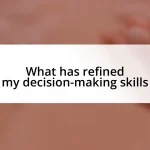Key takeaways:
- Being a virtual assistant requires adaptability, effective communication, and diverse skill mastery to meet clients’ evolving needs.
- Time management strategies, such as time blocking and setting clear goals, are essential for productivity and reducing stress.
- Building strong client relationships through active listening and regular communication fosters trust and collaboration.
- Continuous learning and seeking feedback are crucial for professional growth and enhancing service delivery.

Understanding Virtual Assistant Work
Understanding virtual assistant work involves more than just administrative tasks; it’s about being a multi-talented resource for clients. I remember my first client, who was overwhelmed with daily emails and schedule management. I took that stress off her shoulders, which made me realize how impactful this role can be.
Every day is a new adventure as a virtual assistant. One moment, I could be researching a topic, and the next, I’m crafting social media posts that truly resonate with an audience. Does the thought of juggling different tasks feel daunting? From my experience, embracing variety has not only kept my work exciting but has also allowed me to hone a diverse skill set that continually surprises me.
Communication is the backbone of what we do. I once worked with a client who had a distinct vision but struggled to articulate it. By actively listening and encouraging dialogue, I helped bring their ideas to life. It made me realize that understanding a client’s needs isn’t just about being task-oriented; it’s about fostering a partnership built on trust and clarity.

Essential Skills for Virtual Assistants
When it comes to being an effective virtual assistant, adaptability tops my list of essential skills. Every client is unique, and their needs can shift rapidly. I recall a time when a client suddenly pivoted their business strategy, and I had to quickly shift gears to support this new direction. Keeping an open mind and being flexible not only makes my job easier but also strengthens the trust we share.
Another critical skill is proficiency in technology tools. I’ve spent countless hours mastering various software applications, from project management tools like Trello to communication platforms like Slack. I remember the sense of accomplishment when I learned to use a new tool that streamlined my workflow. Being tech-savvy not only enhances my efficiency but also enables me to assist clients with minimal hiccups.
Time management is the glue that holds my daily tasks together. Early on, I realized that keeping a structured schedule was crucial for productivity. One technique I often use is the Pomodoro Technique, where I work in focused bursts followed by short breaks. This method transformed how I approach my workload, allowing me to maintain a balance between being efficient and staying energized throughout the day.
| Essential Skill | Description |
|---|---|
| Adaptability | Ability to adjust to clients’ changing needs and business strategies. |
| Tech Proficiency | Familiarity with various tools and software to enhance productivity. |
| Time Management | Effective scheduling and task prioritization to optimize workflow. |

Time Management Strategies for Success
Finding effective time management strategies has been transformative in my journey as a virtual assistant. I’ve learned the hard way that without a plan, tasks can slip through the cracks. There was a week filled with deadlines that felt overwhelmingly close, and that’s when I decided to prioritize my tasks using a simple matrix I created. This strategy visually sorted my responsibilities into urgent and important categories, which helped me tackle what truly mattered without the anxiety that typically weighed me down.
To keep my workflow smooth and my stress levels low, here are some practical strategies I’ve found helpful:
-
Time Blocking: I set aside specific hours for focused work on certain tasks. This way, I know exactly what I’ll be working on at any given time.
-
Set Clear Goals: Each morning, I jot down 3 key tasks I want to accomplish. It creates a clear direction for my day.
-
Use Timers: I’ve found that using a timer for short sprints really helps maintain my focus. It’s almost like a game—can I complete this task before the timer goes off?
-
Prioritize Breaks: I’ve learned that regular breaks are non-negotiable for maintaining long-term productivity. Even a quick walk outside recharges my brain.
By embracing these strategies, I’ve not just survived but thrived. They help me balance my workload while ensuring I give my best to each client. Each technique I’ve adopted is like a small tool in my kit, allowing me to create tailored solutions that enhance both my efficiency and my overall well-being.

Tools That Enhance Productivity
Having the right tools at your fingertips can make a world of difference. For instance, I recently discovered the wonders of Asana for project management. At first, it felt overwhelming with its many features. However, once I invested some time into exploring its capabilities, I found myself organizing tasks seamlessly, tracking progress, and collaborating with clients effortlessly. It’s like having a second brain to remember everything.
Another tool I can’t live without is Evernote. I have countless notes, ideas, and snippets saved in there, and it serves as my digital scrapbook. I once had a client who wanted to brainstorm new marketing strategies on the fly. With Evernote, I quickly pulled up my ideas, and we were able to have a productive session that felt both spontaneous and structured. It really highlighted how having the right tools can unlock creativity during crucial moments.
I’m also a huge fan of Canva for any graphic design needs. As a virtual assistant, I often need to create visually appealing content quickly. I remember a time when a client requested social media graphics last minute. Instead of panicking, I hopped onto Canva, utilized some pre-made templates, and delivered polished designs in no time. Can you imagine how stress-free that made my day? Tools like this can turn potential chaos into streamlined success.

Effective Communication Techniques
Effective communication is the backbone of my role as a virtual assistant. I’ve discovered that active listening is one of my most powerful tools. For instance, when a client expresses frustration about a project, I don’t just hear their words; I tune into their emotions. This approach allows me to address their concerns head-on and creates a deeper level of trust between us. Have you ever noticed how much more connected you feel when someone truly listens? It’s a game-changer.
Another technique that has proven invaluable is the power of asking open-ended questions. I remember a team meeting where we were brainstorming strategies for a client’s campaign. Rather than leading with my ideas, I asked my colleagues, “What challenges have you faced in previous campaigns?” This opened the floodgates for discussion and unveiled insights I hadn’t even considered. Essentially, it transformed the meeting into a collaborative effort, making everyone feel their input was valued. Isn’t it fascinating how a simple question can shift the entire tone of a conversation?
Finally, clarity in my communication ensures that everyone is on the same page. Early on, I learned the hard way that sending vague emails led to misunderstandings. Now, I make it a point to be precise and concise—like when I send updates on project statuses or deadlines. I break down information into bullet points, ensuring nothing gets lost in translation. Have you tried this in your own communication? It not only reduces confusion but also saves everyone valuable time, allowing us to focus on what really matters.

Building Client Relationships
Building strong client relationships has always been a priority for me as a virtual assistant. Early on, a client confessed they felt overwhelmed by their workload. Instead of just taking notes, I proposed regular check-in calls to discuss priorities and progress. This simple gesture not only reassured them but also transformed our collaboration into a partnership. Have you ever felt that sense of relief from knowing you have support? It’s truly amazing how a little extra communication can foster trust and rapport.
One time, I had a client who was hesitant to delegate tasks because they were unsure about my capabilities. To ease their doubts, I suggested a trial period where I would take over a small project. By delivering it not just on time, but with added value, I was able to demonstrate my commitment to their success. Seeing their relief and appreciation was incredibly rewarding. Have you ever experienced that moment when a client finally realizes they don’t have to handle everything alone? It can be a turning point in the relationship.
I also find that showing genuine interest in a client’s goals is fundamental. When I learned that one of my clients was passionate about expanding their business into new markets, I took the initiative to research industry trends and shared insights over coffee—a virtual coffee, of course. The enthusiasm in their voice was palpable, and it sparked deeper conversations about future projects. Isn’t it refreshing when clients appreciate your willingness to go the extra mile? Being invested in their vision not only strengthens our bond but also empowers them to dream bigger.

Continuous Learning and Improvement
Continuous learning and improvement are vital in my journey as a virtual assistant. There’s always something new to learn, whether it’s software updates, project management tools, or trends in my clients’ industries. For instance, I remember diving into a new project management platform that I’d never used before. I dedicated a weekend to explore its features and find ways it could streamline my workflow. The satisfaction of mastering that platform felt incredible, much like completing a challenging puzzle. Have you ever embarked on a learning adventure that paid off in unexpected ways?
In my experience, attending workshops and webinars has been a game-changer for professional growth. I vividly recall a webinar on productivity hacks that introduced me to the Pomodoro Technique. Implementing this time management strategy made a noticeable difference in my focus and efficiency. I often share these techniques with clients—it’s like planting seeds of knowledge that they can nurture in their own work. Isn’t it rewarding to share insights that not only enhance your own skills but also empower others?
Another critical aspect of continuous improvement is seeking feedback. I’ve made it a point to proactively ask clients for their thoughts on my performance. An instance that stands out was after I completed a large project; I requested feedback, and the client shared their appreciation but also noted a few areas for improvement. At first, receiving constructive criticism felt daunting, but I realized it was a goldmine for my development. Doesn’t it feel empowering to know that you can always grow and adapt? Embracing that mindset is what keeps me motivated and evolving in this dynamic field.














